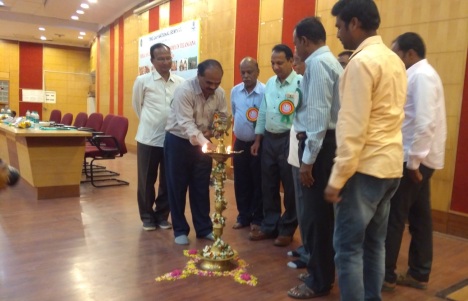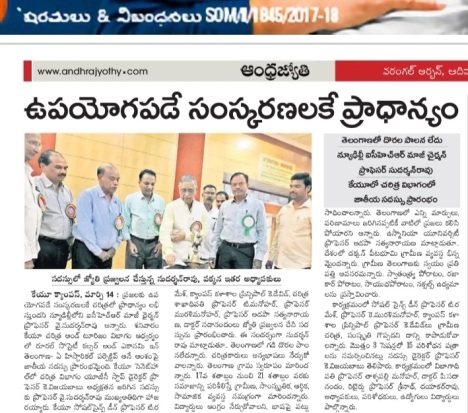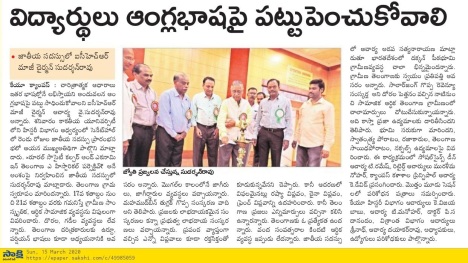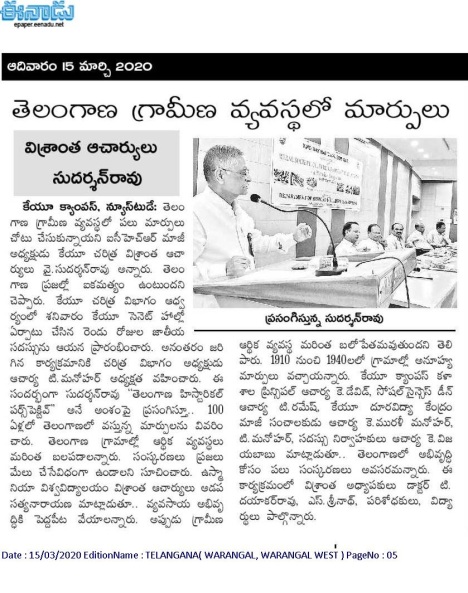|
The National Seminar on Rural Society, Culture and Economy in Telangana – Historical Perspective – held at the Kakatiya University on March 14th and 15th 2020 [2]
Keynote address by Adapa Sathyanarayana 11.07to 11.55 am: He started his presentation with “Namaskaram”! He praised Sudharshan Rao, remembered A. Bobbili and then touched upon his topic. S. Kesava Iyengar has studied the earlier Hyderabad state and brought out details of Telangana villages in his two volumes published in 1931. According to Adapa, the “Arya vartha” is different from that of the Telangana village / society / economy, because, here, there was no varna system. In “Aryavartha,” the lands were owned by the “dwijas” – Brahmins and Khatriyas, whereas, here, “Dora-Patel-Patwari-Komiti[10]” were controlling. In Telangana, no Khsatriya was there. The autonomy of Teangana villages were there and they continued up to 19th century. “Dora” as a political organization / status / excessive power / exploitation developed and was the reason for the 1915 armed struggle[11]. The 150 years “Dora” system survived as the integral institution of Telangana. The concept, “coercion and consent” worked faithfully in the Telangana “village republic”. Islam, Sufism, Christianity have been here, but, anti-Islam was a different aspect in Telangana, because of Razak Khan atrocities. Kutub Shahis were not crusaders. The caturvarna is not here, but, “Dora-Patel-Patwari-Komuti” type system existed.
V. Ramesh, Dean, Social Sciences: He had dealt with the issue in sociological angle. In fact, the sociological issues are only, now, discussed in “historical” façade. He pointed out that agricultural, industrial and IT revolutions have affected and changed society much.
Murali Manohar, DDE to 12.20 pm: He responded specifically and briefed them into three points. 1. Using the henchmen / private army to collect revenue: He pointed out that every tax-collector used henchmen to collect revenue. To establish control over the lands and land revenue, they used such power centres, and they were called as “Gadee.” 2. Most of the rulers of Telangana had been coming from outside: The dominant Reddy-Khamma-Velama were only ruling and collecting taxes using private armies. Thus, they had control over the economy by means of productive resources – hills, rivers, lands etc. They became “Doras” coming from outside and now the corporates have replaced them. Yet, it is well known how “Reddy families” have been controlling industries and business. Even in villages, they have control over fertilizer shops and others, keeping nearby places and making farmers to come to their places to buy. Because of these dominance only, the Naxalite and Telengana armed struggle movements developed. 3. Researchers and historians have to answer or find out as to “why these practices are continuing?” Indirectly, he was refuting the theory of Adapa and responding to the issues raised by him.
David, Principal, Local Arts College 12.22 to 12.30 pm: As he is a science professor, he pointed out that Indian spirituality has been accommodative and hence treated everything divine. As Indians believed everything is divine, they could worship stone hills, trees, rivers, and so on as gods and goddesses. God is white in Europe, black in Africa and brown in India. Brahma is brown. Energy is there everywhere, it is there in the atom. Thus, the festivals are celebrated in all forms. “daitya-shudra” types of gods, goddesses and festivals are there to satisfy all. Therefore the SC-ST-BC-Minority unity should be preserved. Sudharshan Rao, Chief Guest 12.31 to 1.14 pm: In his presidential address, he was responding to his preceding speakers. He pointed out that the statistical data study in history cannot be accepted, as the data differ and all cannot be equated to form any theory to come to a conclusion. The British method of revenue collection as continued through the Dakkani Mohammedan rulers. Vinoba Bhave’s “Bhudhan movement” was unique, as he tried to distribute lands to landless people. But, it is not know, how the lands were distributed. Had the lands been distributed, perhaps, there would not be any people without lands.
|
The first technical session was held in the mini-seminar hall, as the papers were with PPT. The [paper presenters were – Linga Panduranga Reddy, Anjaiah K. V. Ramakrishna Rao and Kishan Rao.

Capt L Panduranga Reddy (retd), presented a paper on the significance of “Fazli year” followed by the Moghuls for the purpose of revenue collection.
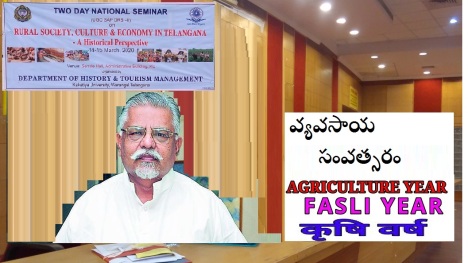
Prof. Srinath presented a paper in Telugu, based on a novel in Telugu. The narratives given in a novel are taken for the social divisions and struggle for interpretation.
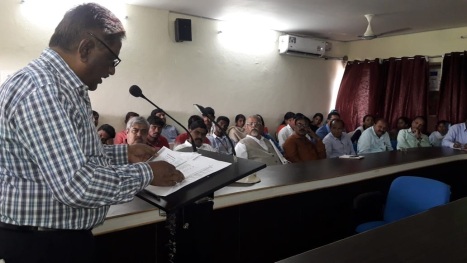
Dr G. Anjaiah detailed about the harmony of places of worship and certain festivals celebrated in Telangana.
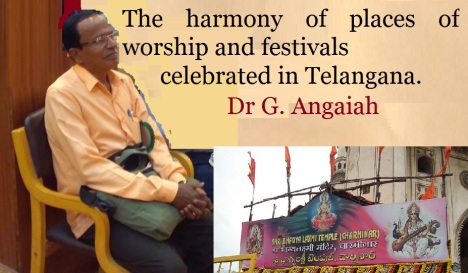
K. V. Ramakrishna Rao presented his paper on “Quarrying, granites and politics: Internal consumption for cultural development or export for economic exploitation?”
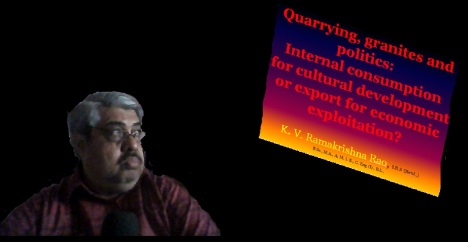
Prof V. Jaikishan presented a paper on wootz steel manufactured in Telangana for thousands of years.
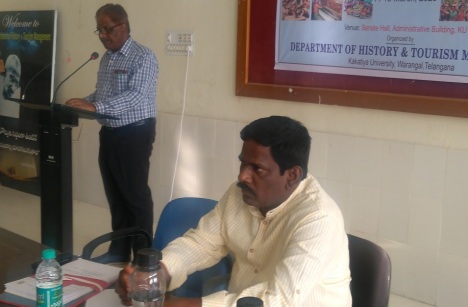
After PPT presentation, the technical session continued at the seminar hall, where the second session was chaired by Prof Srinath and papers presented. As usual most of the papers had been of the repetitive nature, in the sense that such narratives, papers and books have already been available and the paper-readers tell nothing new.
- Ironically, the paper-readers who talk about Muharram do not know which sect of Islam celebrate. Coming to Sufism, it is evident that they do not the fundamentals. Just by reading books or taking such narratives from others, they are reading papers and even try to conclude that such and such conclusions are applicable to entire Telangana, Telugu speaking people and even whole India.
- Conversion to Islam – here also, the paper-readers do not the significance of caste and class as per the provisions of the constitution. Any person converting Islam, becomes a Muslim and he is strictly or supposed to follow the basic tenets of Islam without fail. However, what happens when a Hindu converts into Islam, what happens to his caste, they do not know.
- Madigas becoming Mohammedans and becoming pir – One paper-reader claimed that the SC converting to Islam is elevated and even becomes Imam and Pir and they are respected. When asked, in which denomination, the converted SC would get and the Jamat would issue a certificate, he could not answer.
- I note that most of the papers on “kullayappa, kullayaswamy, topiwala sahib, turuka devadu, pir-sawmi ”etc., rely upon the local narratives and of course the book of Afsar Mohammed[12]. However, had the paper-readers read his book carefully, they would not have come to such conclusions.
- First of all, historians cannot use the term “dalit,” like journalists or populist writers or politicians who talk on stages. I pointed out / have been pointing out for many years, as the National Commission for SC and ST long back issued instructions. Recently, the Communist government of Kerala also issued such instructions. Yet, the paper-readers use such expressions without understanding the Presidential Order, 1950 and many Supreme and High Court judgments.
© K. V. Ramakrishna Rao
17-03-2020
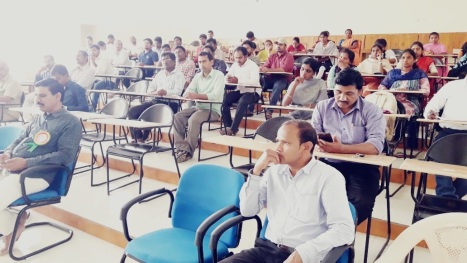
[1] From the brochure sent by the organizers. He read from the brochure, as I could follow him carefully.
[2] : Tradition says that the velamas were in race of Khastriya, who ruled over the country to the north of Narmada river. As they vanquished by a mightier people Raja Pratapa Rudra of Kakatiya dynasty attracted by their physique and commanding features welcomed them to his Kingdom and conferred on them the command of 77 forts in his kingdom. They gradually became agriculturists and traders. In Telangana their main occupation is agriculture. Many of them held lands and worked as tenants. A few of the velamas were rich landlords and village officers.
[3] The social conditions of Jagirdari village are revealed round the Gadee in 19th, and first half of the 20th century. Gadee is the residue place of Dora, in which he lives with his family members, Adabapa and Dasis (slave girls) and their children and a large number of vetti workers and bhagelas This place is the centre of political, social and economical activities. What decision was taken in Gadee is implemented in Jagir village. These Gadees persisted in 19th century and first half of the 20th century.
[4] This system prevails in Telangana during 19 th century and first half of the 20th century. By the 18th century in deccan, political stabilisation was established by Asafjahs. They initiated various tenures to bring the land under cultivation. “Like most of the Deccan states, in Telangana too “bara balutadars” played an important role in colonising the region and setting up villages and developing agriculture”
[5] The deshmukhs in the process of becoming landlords with their own patta lands practically usurped the authority of the state and kept the whole countryside in their possession to establish their Rajyam. They established their authority over government property. They established their supremacy over wastelands, government lands, trees, tanks, steams in the village. They imposed restriction on peasants and shepherds grazing their cattle and on labourers collecting firewood from such common resource lands.
[6] From the brochure sent by the organizers. He read from the brochure, as I could follow him carefully
[7] From the brochure sent by the organizers. He read from the brochure, as I could follow him carefully
[8] From the brochure sent by the organizers. He read from the brochure, as I could follow him carefully
[9] From the brochure sent by the organizers. He read from the brochure, as I could follow him carefully
[10] Komatis are an integral part of the peasant society. This is the name for Telugu traders, shopkeepers and money lenders mostly found in Telangana. They played crucial role in agricultural finance and benefitted immensely. It is considered to be a wealthy and prosperous caste. They were mainly found in their traditional occupation i.e. trade, commerce and money lending. Very few of them worked as cultivators and agricultural labourers.
[11] During late nineteenth century the deshmukhs in the process of becoming land lords usurped the authority of the state and kept the whole country side in their possession and established Dorala rajyam. In Nalgonda District the most notorious, dora families were Rapaka, Janna Reddy, Nukala, Rama Sahayam, Pingali and Lingala. The number of families increased in last quarter of nineteenth century through the matrimonial relations established with the doras and following the doras practices. New Doras converted these services castes as “Vetti workers”. Untouchables and low caste peoples were converted as “bhagela”s. As the landlords owned large land fields due to reforms of Salarjung and they were forced to cultivate commercial crops like castor and groundnut by the British. These circumstances forced the landlords to introduce vetti and bhagela system.
[12] Afsar Mohammed, The Festival of Pirs – popular Islam and Shared Devotion in South India, Oxford University Press, USA, 2016.
Filed under: agrarian, agriculture, ambedkar ideology, ambedkar thought, archaeology, arya, Aryan, bifurcate, Brahma, category, compassion, conduct, conference, constitution, control, controversy, coolie, dalit, dalit muslim, deshmuk, deshmukh, diwan, dora, Dravida, Dravidian, gadi, interpretation, K. V. Ramakrishna Rao, labour, maid, Mala, marxism, Marxist historian, Marxist-Leninist, monument, moral values, morality, oppressed, patel, S. Kalyanaraman, self-determination, telangana, Telangana History Congress, telengana, telugu, tour, tourism, tradition, tribal, tribe, worker, writer | Tagged: aryan, boundary, catur varna, colonial slavery, Dravida, goddess, jagirdar, mother goddess, navidar, patel, patwari, political economy, rural society, secondary, slave, slavery. colonial, society, telangana, Telangana History Congress, varna, varnashram, varnashrama | Leave a comment »


